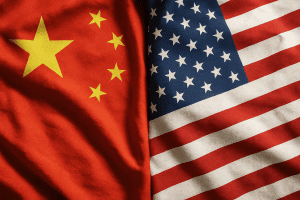China: The global financial landscape faced a significant jolt as Wall Street futures dropped by up to 3%, reacting sharply to China’s latest move in the escalating trade war—a 34% tariff on all US goods. This drastic measure, announced unexpectedly, marks one of the most aggressive retaliatory policies by Beijing against Washington’s trade restrictions. The tariff hike is expected to have profound implications, not just for the US and Chinese economies but for the entire global trade ecosystem.
The US and China, as the world’s two largest economies, have been locked in a prolonged trade conflict since 2018, with periodic escalations that have disrupted supply chains, impacted corporate earnings, and increased market volatility. However, the latest move by China signals a potential new phase in the trade war—one that could create lasting economic repercussions for investors, businesses, and policymakers.
The immediate aftermath of China’s tariff hike has been felt across global stock markets, particularly in the Dow Jones, S&P 500, and Nasdaq futures, all of which saw steep declines. Investors are now grappling with the uncertainty surrounding US-China relations, fearing that this could trigger further countermeasures from the US government, leading to an intensified economic standoff.
 This development raises several critical questions: How will US companies respond to these increased tariffs? Will American consumers face higher prices? How will global markets adjust to this new economic reality? These are the pressing concerns that will shape market sentiment in the coming weeks, making this trade war escalation one of the most crucial turning points in recent financial history.
This development raises several critical questions: How will US companies respond to these increased tariffs? Will American consumers face higher prices? How will global markets adjust to this new economic reality? These are the pressing concerns that will shape market sentiment in the coming weeks, making this trade war escalation one of the most crucial turning points in recent financial history.
Also Read: With US Tariffs, India’s Jewellery Exports Set for a Sharp Decline
Impact on Wall Street Futures and Global Stock Markets
The announcement of China’s 34% tariff on all US goods sent shockwaves through financial markets, triggering a significant sell-off in Wall Street futures. Investors reacted swiftly to the news, fearing that escalating trade tensions could lead to a broader economic slowdown, supply chain disruptions, and a decline in corporate earnings.
Major US Stock Indices Reaction:


🔻 S&P 500 Futures declined by 3.0%, indicating broad-based selling across multiple sectors.
🔻 Nasdaq 100 Futures dropped by 2.5%, with tech stocks bearing the brunt due to their heavy reliance on China for production and revenue.
These sharp declines suggest that investors anticipate a negative impact on corporate profitability, especially for industries with significant exposure to Chinese markets. The fear of additional retaliatory measures from the US government has further added to the uncertainty.
Impact on Global Stock Markets:
The ripple effect of China’s tariff announcement was not limited to the US; global markets also experienced a wave of sell-offs:
🌏 Asian Markets: The Shanghai Composite and Hang Seng Index declined as Chinese stocks faced pressure due to fears of counter-sanctions from the US.
🌍 European Markets: The FTSE 100, DAX, and CAC 40 saw declines as investors worried about the potential spillover effects on European businesses with US-China trade exposure.
🌎 Emerging Markets: Stock indices in countries heavily dependent on US-China trade, such as South Korea and Taiwan, witnessed capital outflows and currency fluctuations.
Key Sectors Affected by China’s 34% Tariff on US Goods
China’s sweeping tariff hike will hit multiple US industries, particularly those with heavy trade exposure to China. The following sectors are likely to suffer the most significant disruptions:
1. Technology & Semiconductors
📉 Companies Impacted: Apple, Nvidia, Intel, AMD, Qualcomm, and other semiconductor firms.
🔹 Why it Matters: China is both a key consumer and a major supplier in the semiconductor industry. Higher tariffs could lead to:
✔️ Increased production costs for US tech companies.
✔️ Potential supply chain disruptions for chipmakers.
✔️ Lower demand for American electronic goods in the Chinese market.
2. Agriculture & Food Products
📉 Companies Impacted: Archer Daniels Midland, Tyson Foods, Cargill, US soybean farmers.
🔹 Why it Matters: China has historically been one of the largest buyers of US agricultural products, especially soybeans, pork, wheat, and dairy. The 34% tariff could lead to:
✔️ Plunging export volumes as Chinese buyers shift to Brazil and Argentina.
✔️ Price drops for US farmers due to excess supply.
✔️ Further financial distress in the American farming sector, which is already struggling from previous trade conflicts.
3. Automobiles & Electric Vehicles (EVs)
📉 Companies Impacted: Tesla, General Motors, Ford.
🔹 Why it Matters: China is one of the largest auto markets in the world. Higher tariffs will:
✔️ Make US electric vehicles (EVs) and auto parts more expensive, reducing competitiveness.
✔️ Hurt Tesla’s China sales, where it has significant investments in Gigafactories.
✔️ Force automakers to consider local production or shift operations to non-tariff regions.
4. Industrial & Manufacturing
📉 Companies Impacted: Caterpillar, Boeing, 3M, General Electric.
🔹 Why it Matters: US industrial giants rely on Chinese contracts and raw material imports. Tariffs could:
✔️ Reduce new aircraft orders from Boeing as China explores alternative suppliers.
✔️ Disrupt supply chains for construction and heavy machinery companies.
✔️ Increase operational costs due to expensive imports of Chinese-made components.
Investor Sentiment: Fear, Volatility, and Market Uncertainty
💹 VIX (Volatility Index) Surges: The market’s “fear gauge” spiked sharply, indicating investor anxiety over escalating trade tensions.
📉 US Dollar Weakens: Concerns over prolonged trade wars led to fluctuations in the USD, favoring safe-haven assets like gold.
🔻 Bond Yields Drop: Investors flocked to US Treasury bonds, seeking safety amid rising uncertainty.
What’s Next? Will the US Retaliate?
The ball is now in Washington’s court. The Biden administration has several potential responses:
1️⃣ Retaliatory Tariffs: The US could impose additional import duties on Chinese products, further escalating the trade war.
2️⃣ Trade Negotiations: Diplomatic discussions could help de-escalate tensions and prevent further economic fallout.
3️⃣ Economic Stimulus Measures: The US government might introduce financial support for affected industries, particularly in agriculture and manufacturing.
The next few days and weeks will be crucial in shaping global economic policies and market stability. Investors and businesses must closely monitor developments as the US and China navigate this latest economic crisis.
Why Did China Impose 34% Tariffs on US Goods?
China’s decision to impose a 34% tariff on all US imports marks a significant escalation in the ongoing US-China trade war. The move comes in direct response to recent US trade policies that have imposed higher tariffs and trade restrictions on Chinese goods and technology.
The key reasons behind this tariff increase include:
1. Retaliation Against US Tariffs
The Biden administration has been tightening its trade policies against China, imposing new tariffs and trade restrictions on key Chinese sectors, such as:
✔️ Electric Vehicles (EVs) – The US raised import duties on Chinese EVs and lithium batteries, impacting companies like BYD and CATL.
✔️ Solar Panels & Green Energy – Tariffs on solar components and batteries aim to protect the US clean energy market from low-cost Chinese competition.
✔️ Advanced Technology Products – Restrictions on semiconductors and AI chips have limited China’s access to crucial components needed for its tech industry.
China’s 34% tariff is a direct countermeasure to these policies, signaling that Beijing will not back down in the face of US trade aggression.
2. Protecting Domestic Industries
China is aiming to boost local manufacturing and reduce dependence on US imports by making American goods significantly more expensive. This strategy:
✔️ Encourages Chinese consumers to buy domestic alternatives rather than imported US products.
✔️ Supports China’s “dual circulation” strategy, which focuses on growing internal markets while maintaining selective global trade.
✔️ Shields Chinese industries from foreign competition, particularly in sectors like automobiles, technology, and agriculture.
3. Strengthening China’s Economic & Political Position
Beyond trade, the tariff move is also a geopolitical statement. By implementing high tariffs:
✔️ China is asserting its economic independence, showing that it has the power to retaliate.
✔️ Beijing is leveraging trade policy as a tool for political influence, especially amid tensions over Taiwan, semiconductor supply chains, and military policies.
✔️ China aims to test US resilience, seeing how American businesses and policymakers react to economic pressure.
Global Market Reaction to China’s 34% Tariffs
The impact of China’s sweeping tariff increase was felt globally, sending shockwaves through Asian, European, and US markets. Investors feared that an intensified trade war could lead to a slowdown in global economic growth and disrupt supply chains.
1. Stock Market Sell-Off in Asia
🌏 Shanghai Composite Index – Dropped by 2.5%, as investors worried about potential economic strain on Chinese businesses.
🌏 Hong Kong’s Hang Seng Index – Fell by 3.2%, with tech and export-dependent stocks hit the hardest.
🌏 Nikkei 225 (Japan) – Declined due to fears of trade disruptions affecting Japanese suppliers to both the US and China.
2. European Markets Face Declines
🌍 FTSE 100 (UK) – Down by 1.8%, as UK firms with US-China exposure, such as luxury brands and energy companies, faced uncertainty.
🌍 DAX 40 (Germany) – Dropped by 2.4%, as German automakers (BMW, Volkswagen) and industrial firms saw trade risks rising.
🌍 CAC 40 (France) – Declined 2.0%, reflecting worries about reduced global demand in sectors like aviation and luxury goods.
3. Commodity & Currency Market Volatility
📉 US Dollar Weakens – The USD index dropped by 0.6%, as investors worried about the negative impact on US trade and corporate earnings.
📈 Gold Prices Surge – Gold climbed 1.5%, as investors rushed to safe-haven assets amid rising uncertainty.
📉 Oil Prices Dip – Crude oil fell by 1.2%, as markets speculated on a potential slowdown in global trade activity.
What’s Next for the US and Global Markets?
The US-China trade war is heating up, and further escalation could lead to:
🚨 Increased Market Volatility – Investors may see more fluctuations in global stock markets, impacting portfolio performance.
🚨 Supply Chain Disruptions – Companies dependent on Chinese imports or exports may experience higher costs and delays.
🚨 Higher Consumer Prices – Tariffs could raise prices on goods, contributing to inflation in both the US and China.
🚨 Potential US Retaliation – The Biden administration may introduce new measures to counter China’s move, further escalating the trade war.
Investor Takeaway
For investors, the current US-China trade tensions highlight the need for diversification and risk management:
✅ Monitor Global Market Trends – Keep an eye on trade developments that could impact specific sectors.
✅ Consider Defensive Stocks – Sectors like healthcare, utilities, and consumer staples may be more resilient.
✅ Look at Safe-Haven Assets – Gold, bonds, and other low-risk investments could provide stability during uncertain times.
✅ Watch for Buying Opportunities – Market dips could present buying opportunities for long-term investors.
Conclusion: The Future of US-China Trade – Escalation or Resolution?


For the US, this presents a dilemma—should it retaliate with additional tariffs or seek diplomatic negotiations to prevent further economic damage? For China, the move is a clear message that it is willing to take strong measures to counter US trade restrictions, even at the cost of short-term economic strain.
If the Biden administration chooses to escalate the situation by imposing new tariffs on Chinese goods, the trade war could intensify, further disrupting global supply chains, corporate earnings, and consumer prices. Conversely, if diplomatic efforts are made to reach a trade resolution, markets may stabilize, and businesses could find alternative ways to navigate these challenges.
Key Takeaways for Investors & Businesses:
✅ Increased Market Volatility: Investors should prepare for fluctuations in stock prices, currency values, and commodity markets.
✅ Sectoral Impacts: Industries like technology, automobiles, and agriculture will be directly affected by China’s tariff hike.
✅ Potential Inflationary Pressure: Higher tariffs could lead to increased prices for US consumers, impacting purchasing power.
✅ Investment Strategies: Safe-haven assets like gold, bonds, and defensive stocks may provide stability in uncertain times.
✅ Geopolitical Risks: The trade war is not just about economics but also about global power dynamics between the US and China.
As the world watches how Washington and Beijing navigate this latest economic flashpoint, the next few weeks will be critical in determining the future of US-China trade relations. Will there be a path toward de-escalation, or are we witnessing the beginning of a prolonged economic conflict that reshapes global trade?
For real-time updates on market movements, trade policies, and investment strategies, visit the NSE website: www.nseindia.com.

